For centuries, composers have been writing classical music about death.
In fact, death and dying have inspired some of the saddest works of classical music ever written.
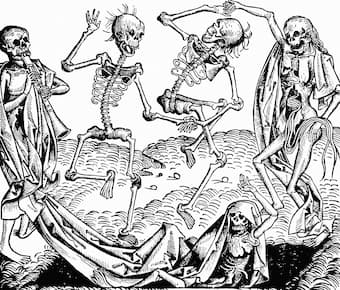
The Dance of Death from Liber Chronicarum, 1493.
Today we’re looking at the stories behind fifteen pieces of classical music about death.
Dido’s Lament by Henry Purcell (ca. 1688)
Dido’s Lament is from English composer Henry Purcell’s early opera Dido and Aeneas, based on Virgil’s Aeneid.
In Dido and Aeneas, Trojan warrior Aeneas flees war-torn Troy. He intends to land in Italy, but his ship gets blown off course and lands in Carthage instead.
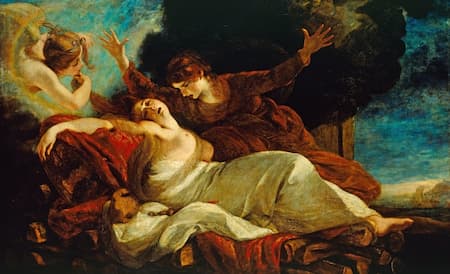
Joshua Reynolds: The Death of Dido, c. 1775-1781 (Royal Collection Trust)
Aeneas and Dido, the Carthaginian queen, fall in love, but he finds he is unwilling to spend the rest of his life with her and leaves.
In despair, Dido stabs herself and a funeral pyre is set ablaze, providing a sign to the departing Aeneas that she has died rather than live without him. Before she dies, she sings this aria.
This lament is famous for its mournful pattern in the baseline, which repeats over and over again.
Komm, süßer Tod, komm selge Ruh by Johann Sebastian Bach (ca. 1735)
Komm, süßer Tod, komm selge Ruh (or “Come, sweet death, come, blessed rest” in English) is a song composed by Johann Sebastian Bach. It was written for solo voice and basso continuo.
The song is written from the perspective of a person who is tired of life and asks for the release of death.
“I want to see Jesus now / and stand by the angels,” the narrator sings. “Life is henceforth complete / therefore goodnight to the world.”
Funeral Anthem for Queen Caroline by George Frederic Handel (1737)
Queen Caroline was George II’s consort. She was a widely beloved figure, especially among lovers of the arts.
Handel had been one of the beneficiaries of her patronage, as well as a close friend. When she died, he was tasked with composing the music for her funeral service.
The sub-dean of Westminster Abbey chose Biblical texts to set and sent them to Handel. He only had a matter of days to set them to music and compose this forty-minute long tribute to the queen.
Die schöne Müllerin by Franz Schubert (1823)
Die schöne Müllerin translated means “The Fair Maid of the Mill.”
This song cycle traces the unrequited love of the singing narrator, who falls in love with a miller’s daughter.
A hunter gives the woman a green ribbon, and the narrator is forgotten. The narrator has a fantasy about his own death and burial.
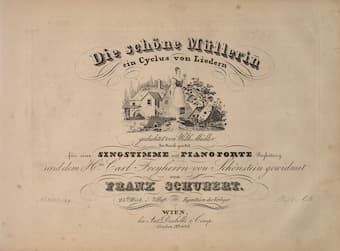
Schubert’s Die schöne Müllerin Diabelli Edition
The final song is a peaceful lullaby sung from the perspective of the brook. It insinuates, rather terrifyingly, that the narrator has died by drowning himself in despair.
Marche au supplice from the Symphonie Fantastique by Hector Berlioz (1830)
Berlioz’s Symphonie Fantastique tells a scary story in music.
At the beginning of the symphony, a young artist falls in love with an idealized beloved (much like Berlioz himself did when he saw an actress named Harriet Smithson performing Shakespeare in Paris).
His obsessive thoughts about his beloved follow the artist everywhere, even after he takes a dose of opium.

Martinet: Harriet Smithson as Ophelia in Hamlet (ca. 1827) (Bibliothèque nationale de France, département Musique)
While under the influence, he dreams that he murders his beloved, and that he is condemned to be executed for his crime. He hallucinates a drug-addled soundtrack to his own death.
Funeral March in Memory of Rikard Nordraak by Edvard Grieg (1866)
In 1866, one of Edvard Grieg’s friends, Rikard Nordraak, died of tuberculosis at the age of twenty-three.
The day that Grieg got the news, he wrote this funeral march.
Nordraak was a talented composer in his own right. He was passionate about Norwegian folksong and cultural identity, and that passion influenced Grieg’s later works. (One of Nordraak’s songs would actually go on to become the Norwegian national anthem!)
Grieg was so satisfied with this work that he asked for it to be played at his own funeral.
Songs and Dances of Death by Modest Mussorgsky (ca. 1875)
In the mid-1870s Mussorgsky wrote four songs about various aspects of the experience of death.
The first portrays the death of a baby. Death comes for the child in the form of a babysitter, who rocks the infant to eternal rest.
The second portrays Death waiting outside the window of a young unmarried woman, behaving as a lover might.
In the third, a drunken peasant stumbles outside into a blizzard and meets Death. Death invites him to dance the Trepek, a Russian folk dance, and the peasant freezes to death.
In the last, Death visits the battlefield by moonlight after a fierce battle. She tells the deceased that she is their new commanding officer, and that even though they had once fought on opposing sides, they are now comrades.
Death and Transfiguration by Richard Strauss (1889)
Richard Strauss was in his mid-twenties when he wrote the famous orchestral tone poem Death and Transfiguration.
It portrays the final hours of a dying artist. Its slow opening features an unsteady rhythm, meant to portray an unsteady heartbeat.
The man tries his best to fight back against the inevitable, but after a struggle, during which he has trouble taking a full breath, he lapses into contemplating memories of his childhood and adulthood.
Eventually the heavens open to him, and he finds transfiguration and redemption in death.
Although Strauss wrote this work as a very young man, he later endorsed its emotional truth. When he was eighty-five years old and, on his deathbed, he famously told his daughter-in-law, “It’s a funny thing, Alice, dying is just the way I composed it.”
Der Abschied from Das Lied von der Erde by Gustav Mahler (1908)
Mahler was spooked by the idea of the “curse of the ninth” – the idea that a composer can only finish nine symphonies before dying, a la Beethoven.
To get around this, Mahler embarked on an orchestral song cycle called Das Lied von der Erde, or The Song of the Earth. It was like a symphony, but also, strictly speaking, not one.
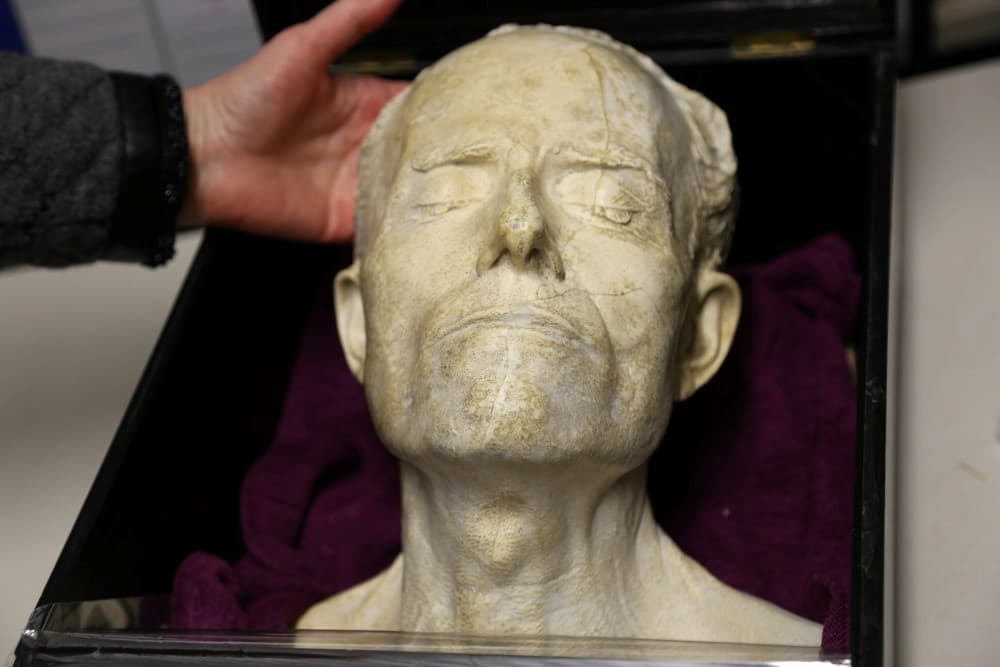
Death mask of Gustav Mahler
The half-hour-long final movement is called “The Farewell” and is a setting of a German adaptation of classical Chinese poetry.
The singer describes the end of a day and waiting for a beloved friend, “to bid him a last farewell.” The music embraces a tone of bittersweet ecstasy.
Isle of the Dead by Sergei Rachmaninoff (1909)
In 1907, composer and pianist Sergei Rachmaninoff saw a black and white reproduction of a painting by Arnold Böcklin called “The Isle of the Dead.”
In this painting, a rowboat approaches a strange rocky island filled with cypress trees – a tree traditionally associated with cemeteries and death.
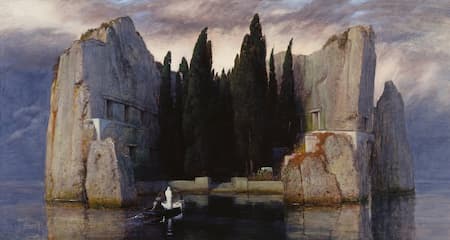
Böcklin: Die Toteninsel (Isle of the Dead) (1880-1886)
Rachmaninoff’s imagination set to work. We don’t know exactly what Rachmaninoff was seeing in his mind’s eye, but the opening rhythms evoke a rowboat slowly making its way through the water. What happens next on the island is up to your own imagination!
Le Tombeau de Couperin by Maurice Ravel (1914-1917)
Composer Maurice Ravel was deeply and personally impacted by the horror of World War I. He served as an ambulance driver and was grief-stricken by the experience.
One of his creative responses to the conflict was this set of piano pieces, which he called Le Tombeau de Couperin.
The music calls to mind delicate French harpsichord music of the Baroque Era, and – on the surface, at least – doesn’t seem to touch on the trauma of the war.
However, every movement is a portrait of a friend who died fighting, which lends the whole work a sheen of deep sadness.
Ravel was criticized for writing a light work with such a heavy subtext. His response was, “The dead are sad enough, in their eternal silence.”
Trauermusik by Paul Hindemith (1936)
Trauermusik (or “Mourning Music” in English) was written the day it was premiered, on 21 January 1936.
Composer and violist Paul Hindemith was in London preparing for the British premiere of his viola concerto Der Schwanendreher. However, King George V died on 20 January, and the concert was canceled.
Over the course of six hours on 21 January, Hindemith wrote this mournful nine-minute piece for solo viola and string orchestra. It was performed on the radio that night.
The Field of the Dead from Alexander Nevsky by Sergei Prokofiev (1939)
In 1938 Sergei Prokofiev composed the soundtrack to the Soviet film Alexander Nevsky, which traced the story of the medieval Russian ruler of the same name, who beat back German invaders in the thirteenth century.
The following year, Prokofiev rearranged the score into a cantata for contralto and orchestra.
In the film, there is a subplot where a woman named Olga has been courted by two knights. She says that she will marry the one who is bravest in battle. After the battle, Olga goes in search of the knights to see if they’ve survived. This song describes the conflict’s grim and bloody aftermath.
Piano Trio No. 2 by Dmitri Shostakovich (1944)
Composer Dmitri Shostakovich began his second piano trio in late 1943 and finished it in August of 1944.
While he was working on the trio, in February 1944, a close friend named Ivan Sollertinsky died in his sleep. Sollertinsky was a brilliant figure who reportedly spoke twenty-six languages, and, among other things, helped to introduce the music of Mahler to the Soviet Union. Shostakovich was devastated at the loss.
According to Sollertinsky’s sister, the trio’s second movement was a portrait of her late brother. It is followed by a tragic dirge.
Listeners have also heard influences of death in the finale. In 1944, word began arriving in the Soviet Union about Nazi atrocities, including stories that Jews had been forced to dance beside their graves. Shostakovich may have drawn on the horror of this idea at the end of the work.
Song for Athene by John Tavener (1993)
Composer John Tavener wrote Song for Athene in 1993, after a family friend named Athene Hariades died young in a cycling accident.
She taught English and drama, so Tavener decided to combine words from Hamlet and the Orthodox funeral service.
Song for Athene gained international fame after it was performed at Princess Diana’s funeral at Westminster Abbey in September 1997.
Conclusion
Composers have always drawn inspiration from universal human experiences.
As this list shows, they have been especially inspired when composing classical music about death and dying.
If you’re mourning, we wish you peace, and we hope that these works of classical music bring you comfort.
For more of the best in classical music, sign up for our E-Newsletter

